

Modelo de un desarrollo sostenible. MICHES, EL SEIBO.

-Los munícipes de este municipio y los miles de visitantes extranjeros cuentan desde ayer con una moderna estructura donde funciona la nueva Supervisoría de la Policía “General Eugenio Miches”, lo que permitirá ofrecer un servicio de calidad a los necesitados y mantener los bajos niveles de criminalidad en que vive esa zona. También se entregaron una camioneta y dos motocicletas para reforzar la prevención. Vista aérea del nuevo cuartel de la Policía en Miches. Modelo de un desarrollo sostenible. EL CEDRO, Miches.- Un asentamiento indígena en la zona de amortiguamiento de Laguna Redonda, donde aparentemente han ocurrido saqueos arqueológicos, ha despertado el interés de investigadores y arqueólogos.
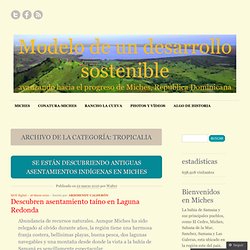
Las piezas encontradas son de la cultura ostionoide, un pueblo agricultor con un nivel cultural muy elevado que migró hasta aquí. El hallazgo fue notificado por el arqueólogo español Adolfo López, quien ofreció detalles preliminares a la comunidad de Miches en la segunda vista pública sobre el proyecto inmobiliario “Tropicalia”, que ejecutará la Fundación Cisneros en tres etapas, con una inversión global de dos millones de dólares.
Empaca y lárgate: La desgracia neoliberal de Detroit. Un recorrido fotográfico virtual. Las primeras planas de todos los medios se inundan con las noticias de los terribles daños que causa a lo largo y ancho del mundo la estúpida ideología llamada Neoliberalismo.
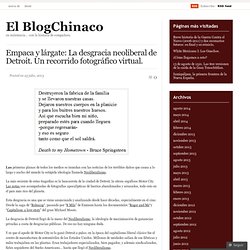
Detroit Future City: A 50-year experiment in urban planning. How long does it take to revive a city burdened with nearly $20 billion in debt, unfunded liabilities, a steadily declining population and over 70,000 abandoned structures?
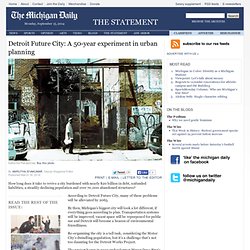
Read the rest of the Issue: More like this. Detroit Future City: A 50-year experiment in urban planning. Planning & Development Department. Attention: Emergency Solutions Grant: Second Allocation FY 2011-12 Substantial AmendmentThe City of Detroit received its final Emergency Shelter Grant allocation of $1,626,338 in 2011.
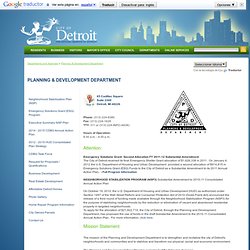
On January 4, 2012 the U.S. Department of Housing and Urban Development provided a second allocation of $914,815 in Emergency Solutions Grant (ESG) Funds to the City of Detroit as a Substantial Amendment to its 2011 Annual Action Plan. - Full Program Information NEIGHBORHOOD STABILIZATION PROGRAM (NSP3) Substantial Amendment to 2010-11 Consolidated Annual Action Plan On October 19, 2010, the U.S. Mission Statement The mission of the Planning and Development Department is to strengthen and revitalize the city of Detroit's neighborhoods and communities and to stabilize and transform our physical, social and economic environment. The Planning and Development Department is comprised of the following divisions: Grant Programs.
Planning and development in Detroit. Planning and development in Detroit includes efforts aimed at enhancing Detroit's economy and quality of life.
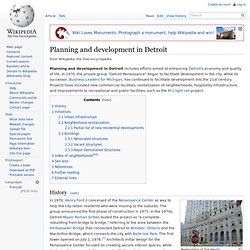
In 1970, the private group "Detroit Renaissance" began to facilitate development in the city, while its successor, Business Leaders for Michigan, has continued to facilitate development into the 21st century. Projects have included new commercial facilities, revitalization of neighborhoods, hospitality infrastructure, and improvements to recreational and public facilities, such as the M-1 light rail project. History[edit] In 1970, Henry Ford II conceived of the Renaissance Center as way to help the city retain residents who were moving to the suburbs. The group announced the first phase of construction in 1971. Planning and development in Detroit. Renaissance Center. The Renaissance Center (also known as the GM Renaissance Center and nicknamed the RenCen) is a group of seven interconnected skyscrapers in Downtown Detroit, Michigan, United States.
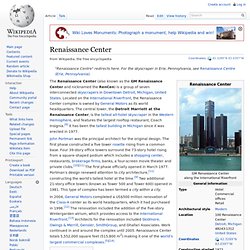
Located on the International Riverfront, the Renaissance Center complex is owned by General Motors as its world headquarters. The central tower, the Detroit Marriott at the Renaissance Center, is the tallest all-hotel skyscraper in the Western Hemisphere, and features the largest rooftop restaurant, Coach Insignia.[9] It has been the tallest building in Michigan since it was erected in 1977. In 2004, General Motors completed a US$500 million renovation of the Class-A center as its world headquarters, which it had purchased in 1996.[12] The renovation included the addition of the five-story Wintergarden atrium, which provides access to the International Riverfront.[13] Architects for the renovation included Skidmore, Owings & Merrill, Gensler, SmithGroup, and Ghafari Associates. History[edit] Location[edit]
5 things Detroit Future City is actually doing after extensive planning. DETROIT, MI -- The 347-page Detroit Future City urban planning document released last year mapped out a wide range of initiatives meant to stabilize and improve neighborhoods while creating jobs and efficient systems in the city, and now dozens of organizations are working to turn some of that planning into reality.
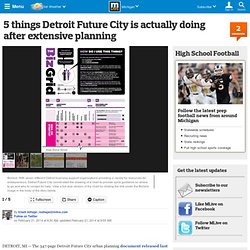
"There are a a lot of people -- a lot of people -- in the city working very hard to affect change. We are just one part of that collective," said Dan Kinkead, Detroit Future City’s director of projects. "Detroit didn't get here over night and it's not going to get out of this over night. It's going to take long term effort and we have to be intrepid in that process... If we all come to together to contribute, we can do a lot more, faster. " Detroit Future City on Thursday introduced a new office and new webpage, listing dozens of pilot projects taking place across the city as officials work to shift the effort from extensive planning to widespread implementation. 1. 2. 3. 4. Renaissance Center. Detroit Future City: A 50-year experiment in urban planning.